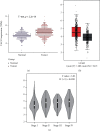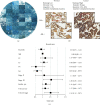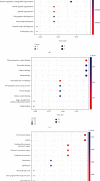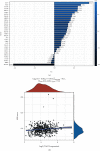High Expression of TACC3 Is Associated with the Poor Prognosis and Immune Infiltration in Lung Adenocarcinoma Patients
- PMID: 35855850
- PMCID: PMC9288335
- DOI: 10.1155/2022/8789515
High Expression of TACC3 Is Associated with the Poor Prognosis and Immune Infiltration in Lung Adenocarcinoma Patients
Abstract
Background: Lung adenocarcinoma (LUAD) has been recognized as one of the commonest aggressive malignant tumors occurring in humans. The transforming acidic coiled-coil-containing protein 3 (TACC3) seems to be a probable prognostic marker and treatment target for non-small-cell lung cancer (NSCLC). Nevertheless, there exist no reports on the association between TACC3 and immunotherapy or other therapeutic interventions in LUAD.
Methods: Premised on the data accessed from The Cancer Genome Atlas- (TCGA-) LUAD, we carried out bioinformatics analysis. The TACC3 expression in LUAD was analyzed utilizing the GEPIA. A survival module was constructed to evaluate the effect of TACC3 on the survival of patients with LUAD. Logistic regression was undertaken to examine the relationship between TACC3 expression and clinical factors. Protein-protein interaction analysis was performed in the GeneMANIA database, and enrichment analysis and identification of predicted signaling pathways were performed using Gene Ontology and Kyoto Encyclopedia of Genes. Additionally, the Cox regression was used to assess the clinicopathologic features linked to the overall survival in TCGA patients. Lastly, we investigated the link between TACC3 and tumor-infiltrating immune cells (TIICs) through CIBERSORT and the "Correlation" module of GEPIA. The association between TACC3 gene expression and drug response was analyzed using the CellMiner database to predict drug sensitivity.
Results: The outcomes illustrated that TACC3 was upregulated and considerably correlated with dismal prognosis in LUAD patients. Moreover, the multivariate Cox regression analysis depicted TACC3 as an independent prognostic marker in LUAD patients. It was also revealed that the expression of TACC3 was related to clinical stage (P = 0.014), age (P = 0.002), and T classification (P ≤ 0.018). Moreover, we discovered that the expression of TACC3 was considerably linked to a wide range of TIICs, especially the T cells and NK cells. Single-cell results found that TACC3 was mainly expressed in the immune cells (especially tprolif cells) and malignant cells. TACC3 gene expression was positively correlated with TMB and MSI, and TACC3 may provide a prediction of the efficacy of immunotherapy. Moreover, the correlation analysis between TACC3 gene expression and immune checkpoint gene expression revealed that TACC3 may coordinate the activities of these ICP genes in different signal transduction pathways. TACC3 is related to biological progress (BP), cellular component (CC), and molecular function (MF). The pathways involved in the interaction network involving TACC3 include nonhomologous end-joining, RNA transport, pantothenate and CoA biosynthesis, homologous recombination, and nucleotide excision repair. Furthermore, we investigated the association between the expression of TACC3 and the use of antitumor drugs, and TACC3 was positively correlated with response to most drugs.
Conclusion: The findings from this research offer robust proof that the expression of TACC3 could be a prognostic marker correlated with TIICs in LUAD. TACC3 can also provide new ideas for immunotherapy as a potential therapeutic target.
Copyright © 2022 Yan Chen et al.
Conflict of interest statement
The authors declare that there is no conflict of interest.
Figures













Similar articles
-
Abnormal TACC3 Expression is an Independent Prognostic Biomarker in Lung Carcinoma.Front Biosci (Landmark Ed). 2022 Aug 30;27(8):252. doi: 10.31083/j.fbl2708252. Front Biosci (Landmark Ed). 2022. PMID: 36042187
-
Increased expression of TTC21A in lung adenocarcinoma infers favorable prognosis and high immune infiltrating level.Int Immunopharmacol. 2020 Jan;78:106077. doi: 10.1016/j.intimp.2019.106077. Epub 2019 Dec 5. Int Immunopharmacol. 2020. PMID: 31812070
-
Identification of CDT1 as a prognostic marker in human lung adenocarcinoma using bioinformatics approaches.PeerJ. 2023 Sep 28;11:e16166. doi: 10.7717/peerj.16166. eCollection 2023. PeerJ. 2023. PMID: 37790630 Free PMC article.
-
The Effect of GLUT1 on the Survival Rate and Immune Cell Infiltration of Lung Adenocarcinoma and Squamous Cell Carcinoma: A Meta and Bioinformatics Analysis.Anticancer Agents Med Chem. 2022;22(2):223-238. doi: 10.2174/1871520621666210708115406. Anticancer Agents Med Chem. 2022. PMID: 34238200 Review.
-
TACC3: a multi-functional protein promoting cancer cell survival and aggressiveness.Cell Cycle. 2023 Dec-Dec;22(23-24):2637-2655. doi: 10.1080/15384101.2024.2302243. Epub 2024 Jan 10. Cell Cycle. 2023. PMID: 38197196 Free PMC article. Review.
Cited by
-
Potential biomarkers of primary resistance to first- and second-generation EGFR-TKIs in non-small-cell lung cancer: a real-world study.Ther Adv Med Oncol. 2025 Apr 30;17:17588359251336632. doi: 10.1177/17588359251336632. eCollection 2025. Ther Adv Med Oncol. 2025. PMID: 40322729 Free PMC article.
-
Development and validation of a radiomic prediction model for TACC3 expression and prognosis in non-small cell lung cancer using contrast-enhanced CT imaging.Transl Oncol. 2025 Jan;51:102211. doi: 10.1016/j.tranon.2024.102211. Epub 2024 Nov 27. Transl Oncol. 2025. PMID: 39603208 Free PMC article.
-
Integrative eQTL and Mendelian randomization analysis reveals key genetic markers in mesothelioma.Respir Res. 2025 Apr 13;26(1):140. doi: 10.1186/s12931-025-03219-4. Respir Res. 2025. PMID: 40223054 Free PMC article.
References
-
- Lauffart B., Gangisetty O., Still I. H. Evolutionary conserved interaction of TACC2/TACC3 with BARD1 and BRCA1: potential implications for DNA damage response in breast and ovarian cancer. Cancer Therapy. . 2007;5:409–416.
MeSH terms
Substances
LinkOut - more resources
Full Text Sources
Medical

